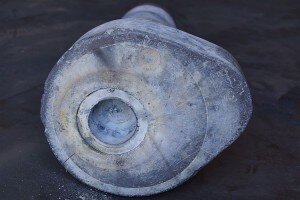Graphite - Non-Wetting in Molten Zinc
Graphite is a fantastic refractory material. Graphite's characteristics include a very low thermal coefficient of expansion, high-temperature tolerance, light weight, and relatively low cost. There are other materials that can be used to build zinc pumps such as MoW or Moly-Tungsten, but the MoW is very expensive and hard to work resulting a pump that is about twenty times more expensive than the graphite pump.
In addition to graphite’s other high-temperature virtues, this ability to shed zinc makes it a maintenance engineers dream. Our zinc pumps are constructed with graphite bases, shaft sleeves, shafts, impellers, and risers. Properly treated graphite readily sheds molten zinc when the pump is lifted out of the melt. (See adjacent photos.)
Unlike molten aluminum, zinc does not wet graphite. As a result, only the impurities in the zinc bath will wet the graphite. This wetting is most often cause by dross that either sinks or floats in the zinc bath. Upon removing a pump from a zinc bath, take a few minutes to gently remove residual dross from the graphite surfaces. Suspend pump while allowing it to cool fully. As any remaining zinc contracts from cooling, it will pull away from the graphite and is easily removed with a gloved hand.Always store pumps and pump components in a warm, dry place to prevent moisture accumulation withing the graphites and silicon carbide bearing materials. Failure to keep a used pump in a warm, dry environment will typically lead to failure shortly after re-introducing the pump into the zinc bath. While moisture can be baked out of graphite will minimal adverse effects, the bearing material so not as forgiving.


